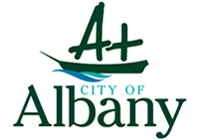Understanding the economic role of City of Albany provides a framework for understanding what policy responses and investment may be appropriate to support the growth of businesses and maintenance of a vibrant economy in the future.
The charts and table below give a broad overview of the role and function of your economy. It helps answer questions such as:
- How much of the City of Albany's economy is driven by meeting the local population needs?
- What proportion of jobs in the area are in goods production or selling of products?
- In which broad sectors are the key strengths of the local economy?
- What contribution do business services make in your area and is it growing?
- Is there a presence of local, state and federal government workers in in the area?
Once you have developed a broad picture of your economy, you can then drill down further with all the detail here.

| Employment composition | ||||||
|---|---|---|---|---|---|---|
| City of Albany | 2024 | 2019 | 2014 | |||
| Industry | number | % | number | % | number | % |
| Agriculture, forestry and fishing | 1,023 | 5.1 | 1,716 | 9.7 | 1,208 | 7.8 |
| Mining | 83 | 0.4 | 54 | 0.3 | 75 | 0.5 |
| Goods related | 7,115 | 35.5 | 6,064 | 34.1 | 5,775 | 37.3 |
| Household services | 8,607 | 42.9 | 6,976 | 39.3 | 5,511 | 35.6 |
| Business services | 1,951 | 9.7 | 1,801 | 10.1 | 1,899 | 12.3 |
| Public administration and safety | 1,274 | 6.4 | 1,152 | 6.5 | 1,017 | 6.6 |
| Total Industries | 20,053 | 100.0 | 17,763 | 100.0 | 15,485 | 100.0 |
Source: National Institute of Economic and Industry Research (NIEIR) ©2025. Compiled and presented in economy.id by .id (informed decisions). Data are based on a 2020-21 price base for all years. NIEIR-ID data are inflation adjusted each year to allow direct comparison, and annual data releases adjust previous years’ figures to a new base year.Learn more. Please refer to specific data notes for more information | ||||||
